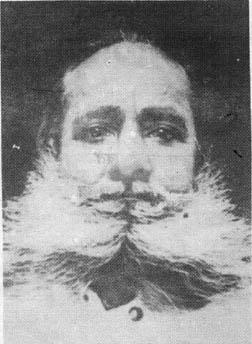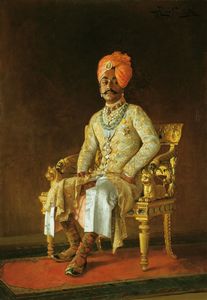|
Eki Movement
The beginning of the ''Eki'' Movement is generally attributed to the events at the Matrikund fair in Chittod. Here, a group of ''adivasis'' agreed to desist from paying taxes to ''jagirdars'' until the Maharana addressed the problems with the ''jagirdari'' system. Beginnings of the Movement The immediate inspiration for the movement was Motilal Tejawat's exposure to the Bijolia movement. Pamphlets associated with the Bijolia movement were circulating throughout Mewar around 1920. Tejawat distributed copies of these pamphlets in Jharol ''thikana'', whose ''jagirdar'' was known to oppress ''adivasis'' and followed up by calling a series of meeting in ''adivasi'' villages in the area, leading to formation of a committee that sought to articulate the grievances and demands of the ''adivasi'' peasantry. In May 1921, Tejawat was able to utilize a large gathering of ''adivasi'' peasants at the annual peasant fair Matri Mundiya near Chittor to spread his message and mobilize his follower ... [...More Info...] [...Related Items...] OR: [Wikipedia] [Google] [Baidu] |
Motilal Tejawat
Motilal Tejawat (Hindi: मोतीलाल तेजावत), (1885–1963) was the leader of the Eki Movement that was agitated in the 1920s in the adivasi-dominated border areas of present-day Rajasthan and Gujarat. Early life Motilal Tejawat was born in Koliyari (now in Jhadol tehsil, Udaipur district, Rajasthan) in 1886. After being educated to the fifth grade, he was employed in the Jhadol ''thikana'' (in present-day Jhadol tehsil) for some time. During his stint at Jhadol, he witnessed the oppressive behavior of the ''thakur'' and his henchmen towards the local Bhil people, which prompted him to resign his position in 1920. He then worked for a shopkeeper in Udaipur city. Soon after obtaining new employment, Tejawat was sent by his employer to Jhadol on business, where the ''thakur'' ordered him to hand over building material belonging to Tejawat's employer; he refused to oblige, and was beaten up and imprisoned by the ''thakur'' until Tejawat's employer was able to ... [...More Info...] [...Related Items...] OR: [Wikipedia] [Google] [Baidu] |
Bijolia Movement
The Bijolia movement (Hindi: बिजोलिया आंदोलन) was a peasant movement in the Bijolia ''jagir'' of the former Mewar state (in present-day Rajasthan in India) against excessive land revenue exactions. Originating in the former ''jagir'' (feudal estate) of Bijolia (near the town of Bijolia in Bhilwara district), the movement gradually spread to neighbouring '' jagirs''. Leadership to the movement was provided, at different times, by Fateh Karan Charan, Sadhu Sitaram Das, Vijay Singh Pathik, and Manikyalal Verma. The movement continued till 1941 after a bitter struggle lasting about half a century, gained national attention and resisted state oppression. Origins Land revenue and other taxes were the main issues behind the movement. Bijolia was a ''jagir'' in Mewar State, ruled by the Parmar ''jagirdar,'' one of the leading 16 nobles (solah umrao) in Mewar State. Peasant discontent started after the accession of Rao Sawai Kishan Singh ji to the ''jag ... [...More Info...] [...Related Items...] OR: [Wikipedia] [Google] [Baidu] |
Chittorgarh
Chittorgarh (also Chittor or Chittaurgarh) is a major city in Rajasthan state of western India. It lies on the Berach River, a tributary of the Banas, and is the administrative headquarters of Chittorgarh District. It was a major stronghold of the Rajput State of Medapata. (modern Mewar) The city of Chittorgarh is located on the banks of river Gambhiri and Berach. Chittorgarh is home to the Chittor Fort, the largest fort in India and Asia. It was sacked thrice; first in 1303 by Alauddin Khalji, again in 1535 by Bahadur Shah of Gujarat, and lastly by the Mughal Emperor Akbar in 1568. Its Hindu Rajput rulers fought fiercely to maintain their independence. On all three occasions when faced with a certain defeat, the men fought to death, while the women committed suicide by jauhar (mass self-immolation). Chittor also has been a land of worship for Meera, It is also known for Panna Dai and Rani Padmini. History Originally called Chitrakuta, the Chittor Fort is said to ha ... [...More Info...] [...Related Items...] OR: [Wikipedia] [Google] [Baidu] |
Begar
Veth (or ''Vethi'' or ''Vetti-chakiri'', from Sanskrit ''visti''), also known as Begar (from Persian), was a system of forced labour practised in the Indian subcontinent, in which members of populace were compelled to perform unpaid work for the government. In the Maratha Confederacy, Veth-begar was practised on a wide scale during the Peshwa's rule. Certain groups of people, such as Brahmins, Kayasthas, Marathas and Kasars (brass-workers) of Saswad region, were exempted from veth-begar. The system continued to be practised in the princely states during the British Raj The British Raj (; from Hindi ''rāj'': kingdom, realm, state, or empire) was the rule of the British Crown on the Indian subcontinent; * * it is also called Crown rule in India, * * * * or Direct rule in India, * Quote: "Mill, who was him .... For example, in the Mewar State, peasants (including those from the upper-caste) were forced to engage in ''begar''. As part of ''veth'', the peasants and low-ca ... [...More Info...] [...Related Items...] OR: [Wikipedia] [Google] [Baidu] |
Idar State
Idar State, also known as Edar, was a princely state located in present-day Gujarat state of India. During the British era, it was a part of the Mahi Kantha Agency, within the Gujarat Division of Bombay Presidency. History Idar State was a princely state that was founded in 1257. Its rulers were Rathore Rajputs. On the question of the succession of the state of Idar, the Sultan of Gujarat, Muzaffar Shah, and Rana Sanga of Mewar supported rival claimants. In 1520, Sanga established Raimal on the Idar throne, with Muzaffar Shah sending an army to install his ally Bharmal. Sanga himself arrived in Idar and the Sultan's army was beaten back. Rana pursued the Gujarati army and plundered the towns of Ahmadnagar and Visnagar of Gujarat, chasing the Sultan's army as far as Ahmedabad. the Rathore's ruled Idar for 12 generations until they were defeated by the Mughals under Murad Baksh in 1656. Idar then became a part of the Mughal Province of Gujarat. In 1729 Anand Singh and Rai ... [...More Info...] [...Related Items...] OR: [Wikipedia] [Google] [Baidu] |
Sirohi State
Kingdom of Sirohi or later Sirohi State (in colonial time) was an independent Hindu state in present-day Rajasthan state of India. The state was founded in 1311 CE and lasted for six centuries until its peaceful dissolution in 1949 CE, when it merged into the erstwhile Bombay State of India. Geography Sirohi State was in the Rajputana agency. It had an area The territory was much broken up by hills and rocky ranges; the Aravalli range divided it into two portions, running from north-east to south-west. The south and south-east part of the territory is mountainous and rugged, containing the lofty Mount Abu, an isolated mass of granite rock, culminating in a cluster of hills, enclosing several valleys surrounded by rocky ridges, like great hollows. On both sides of the Aravallis the country is intersected with numerous water channels, which run with considerable force and volume during the height of the rainy season, but are dry for the greater part of the year. The only river ... [...More Info...] [...Related Items...] OR: [Wikipedia] [Google] [Baidu] |
Vijay Singh Pathik
Vijay Singh Pathik (born Bhoop Singh; 1882–1954), popularly known as Rashtriya Pathik, was an Indian revolutionary. He was among the first Indian revolutionaries who lit the torch of freedom movement against British rule. Much before Mohandas K. Gandhi initiated the Satyagrah movement, Pathik experimented during the Bijolia’s Kisan agitation. After being implicated in the Lahore conspiracy case in 1915, he changed his name to Vijay Singh Pathik. His grandfather's sacrifice in the struggle of 1857 in Bulandshahr district, affected him deeply to be freedom fighter. Early life Pathik was born in 1882 in Guthawali village, Bulandshahar district to Hamir Singh and Kamal Kunwari in a Hindu Gurjar family. His father had taken active part in the Sepoy Mutiny of 1857 and was arrested multiple times. Pathik's Grand Father was Inder Singh, who was Dewan of Malagarh Riyasat and was killed while fighting against the British. While, his birth name was Bhoop Singh, but he changed it to ... [...More Info...] [...Related Items...] OR: [Wikipedia] [Google] [Baidu] |
Sabarkantha District
Sabarkantha district is one of the 33 districts of Gujarat state of India and is located in the northeastern part of the state. The administrative headquarters of the district are located in Himatnagar. Geography Sabarkantha District is bounded by Rajasthan state to the north and northeast, Banaskantha district and Mehsana district to the west, Gandhinagar district to the south and Aravalli district to the southeast. It is spread across an area of 5390 km2. It has a gender ratio of 950 females per 1000 men, and the literacy rate for the district is 76.6%. History During the Western Satrap rule, the region was known as ''Shwabhra'' ( gu, શ્વભ્ર). The region was under rule of Satrap Rudradama in 150 A.D. as indicated in Ashoka's Major Rock Edicts at Junagadh. The river of the region is named as ''Shwabhravati'' which is now known as Sabarmati River. The region is also named in auxiliary text ''Gaṇapāṭha'' of Pāṇini's grammar work, ''Aṣṭādhyāyī''. Duri ... [...More Info...] [...Related Items...] OR: [Wikipedia] [Google] [Baidu] |
Gujarat
Gujarat (, ) is a state along the western coast of India. Its coastline of about is the longest in the country, most of which lies on the Kathiawar peninsula. Gujarat is the fifth-largest Indian state by area, covering some ; and the ninth-most populous state, with a population of 60.4 million. It is bordered by Rajasthan to the northeast, Dadra and Nagar Haveli and Daman and Diu to the south, Maharashtra to the southeast, Madhya Pradesh to the east, and the Arabian Sea and the Pakistani province of Sindh to the west. Gujarat's capital city is Gandhinagar, while its largest city is Ahmedabad. The Gujaratis are indigenous to the state and their language, Gujarati, is the state's official language. The state encompasses 23 sites of the ancient Indus Valley civilisation (more than any other state). The most important sites are Lothal (the world's first dry dock), Dholavira (the fifth largest site), and Gola Dhoro (where 5 uncommon seals were found). Lothal i ... [...More Info...] [...Related Items...] OR: [Wikipedia] [Google] [Baidu] |
Mewar Bhil Corps
The Mewar Bhil Corps is a state armed police force of the Rajasthan Police. The Corps was originally raised by the British Indian government as a military unit along similar lines as units such as the Merwara Battalion and Malwa Bhil Corps. The Corps operated as a regular unit of the British Indian Army until 1938; since then it has been maintained as a para-military force. As of 2015, the sanctioned strength of the Corps was 773 personnel. It is organized, along with 7 battalions of the Rajasthan Armed Constabulary under an Assistant Director General of Police for Armed Battalions. History The Mewar Bhil Corps was established in 1841 under the command of Captain W. Hunter, with its headquarters at Kherwara. The reasons for raising the Corps were two-fold: (a) to provide employment to members of the Bhil tribe, thus ensuring their "good behavior" and (b) to police the "difficult hill country" of Mewar. Organization As of 1891, the Corps had five officers - Commandant, Assista ... [...More Info...] [...Related Items...] OR: [Wikipedia] [Google] [Baidu] |




